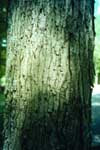Acer rubrum
 |
 |
 |
|
Red Maple |
Leaf of Red Maple |
Bark of Red Maple |
Summary
Foliage: Deciduous broadleaf
Height: 40 to 60 feet
Spread: 40 to 60 feet
Shape: Spreading
Summer foliage is green above, gray underneath, turning yellow to red in fall. Bark is smooth and gray.
Plant Needs
Zone: 3 to 10
Light: Partial shade to full sun
Moisture: Wet, moist, or dry
Soil Type: Sandy, loam, or clay
pH Range: 3.7 to 7.0
Functions
Suggested uses for this plant include shade, street tree, specimen plant, and naturalizing.
Planting Notes
Plant in spring. Transplants readily using small-sized trees that have bare roots. When planting large trees, their roots should be balled and burlapped. Tolerates wide range of soils, except those with a very high pH. Not salt tolerant.
Care
Prune dead and/or damaged wood any time of year.
See Soil Improvement
Problems
The Red Maple is relatively weak-wooded and subject to storm damage. Iron chlorosis (an iron deficiency) is a frequent problem in soils with a high pH.
Alternatives
Consult local sources, including historic or public gardens and arboreta, regarding cultivars and related species that grow well in your area.
Cultivars of ACER RUBRUM
`Red Sunset' has excellent red to orange fall color and a notable pyramidal to rounded shape.
`October Glory' is a well-shaped tree which tends to retain its leaves until later in the fall.
`Autumn Flame' has an early display of red fall color and develops a rounded shape as a mature tree.
Comments
One of the first signs of spring is the flowers of the Red Maple. The profusion of tiny, red flowers against its smooth gray bark is a beautiful sight. Red Maple is also one of the first trees to change color in the fall. When looking for a Red Maple with outstanding red fall color, look for a named cultivar.
This material was developed by Carol Ness as part of the Interactive Design and Development Project funded by the Kellogg Foundation. Mary Miller, Project Director. Diane Relf, Content Specialist, Horticulture. Copyright 1989 by VCE.

